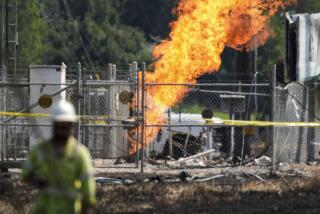Dakota Access oil pipeline protesters cleared from camp, sheriff says; more than 140 arrested
- Share via
Reporting from Along the Cannonball River, N.D. — As helicopters circled overhead, police in riot gear arrested activists Thursday in an effort to break up an encampment of protesters blocking the path of the planned Dakota Access oil pipeline, near the Standing Rock Sioux reservation. By the end of the day, authorities said they had ousted the protesters from their camp.
Police arrested at least 141 people on charges including criminal trespassing, engaging in a riot and conspiracy to endanger by fire, according to the Morton County Sheriff’s Department.
Earlier in the day, dozens of uniformed officers from state and county police and the National Guard advanced in columns, rolling through temporary barricades the pipeline opponents had set up, and eventually forming a 180-degree arc in front of them. Morton County Sheriff Kyle Kirchmeier said that the camp was cleared by the late afternoon.
“You must leave the camp or you will be arrested,” an officer called out repeatedly through a loudspeaker.
The officers moved slowly forward in formation, flanking two military-style vehicles — including a mine-resistant vehicle built to withstand roadside bomb explosions in the Iraq war, and now used as military surplus in state and local police agencies.
The protesters faced down the advancing forces with prayers, songs and torrents of declarations, including “Water is life!” and “We will stand our ground!” For the most part they remained peaceful, though at one point an activist set fire to loose truck tires that were part of a temporary barricade, and a thick column of black smoke rose skyward. A firetruck in the police convoy doused the flames. Anti-pipeline activists expressed dismay at the “chaos” brought by a few.
“Some of our people are very emotional right now,” said Robby Romero, a musician and veteran American Indian rights activist. “They have a huge army in front of them, ready to enact a militarized operation on us. And these are the emotions of centuries-old oppression and genocide. These emotions are starting to rise after months and months of being out here, in these camps, peacefully praying and protecting the sacred waters.”
As Romero spoke, the line of police continued to advance. Some of the officers held up tear gas canisters as they moved through the throng of activists, and some of the “water protectors” were later treated by medics for tear gas trauma and skin wounds from nonlethal bean-bag rounds fired from shotguns to disperse protesters.
Empty school buses were parked nearby, apparently to transport those arrested.
Several protesters heaved logs onto the windshields of the officers’ military-style vehicles.
While some of the protesters held their ground, others slowly retreated.
Police and activists have squared off during the months-long protest over a pipeline project that has bloomed into a national controversy.
Activists accelerated their protests this week when some set up dozens of teepees and more than 100 tents on private property and directly in the path of the planned 1,172-mile, $3.78-billion pipeline.
Native American protesters declared “eminent domain,” saying they were reclaiming land ceded to the Great Sioux Nation in the 1851 Ft. Laramie Treaty but later taken away. The action has the backing of the Standing Rock Sioux and Cheyenne River tribes.
They established what they called the “Treaty Stronghold Camp” in order to keep the pipeline project from crossing the highway and moving farther east, toward the Missouri River, where they say a spill could jeopardize their water supply and that of 17 million other Americans.
By midafternoon Thursday, work crews and earth-moving equipment could be seen just across Highway 1806. There, flanked by uniformed officers and a private security force, they watched from a nearby ridge. It appeared they were waiting for protesters to be cleared so that work on the pipeline could resume.
The land was purchased recently by Energy Transfer Partners, the Fortune 500 pipeline company intent on finishing the pipeline and beginning to pump upward of 570,000 barrels of oil from northwestern North Dakota to southern Illinois. This week the pipeline company demanded that those in the path of the pipeline be “prosecuted to the full extent of the law.”
Authorities began massing earlier this week, urging protesters to retreat to a larger encampment that has been home to hundreds, and sometimes thousands, of protesters.
One who refused was Helen Redfeather, a Lakota Sioux from Wounded Knee, S.D., who sat watching the chaos from a log at the entrance to the stronghold camp. “This is exactly what happened to us during the occupation in 1973,” the grandmother said angrily, “and now they’re it again. History repeats itself.”
A few minutes later, Redfeather was arrested, by one account after refusing to budge from the path of an oncoming BearCat military-style vehicle. Soon National Guard and black-clad state police were moving through the stronghold camp, arresting people and taking down their teepees.
Tolan is a special correspondent. The Associated Press contributed to this report.
ALSO
Even Rev. Jesse Jackson on horseback can’t end pipeline showdown
Clashes, arrests and fears — North Dakota pipeline protest at a boiling point
Shailene Woodley arrested while peacefully protesting Dakota Access pipeline in North Dakota
UPDATES:
10:15 p.m.: This article was updated with the latest number of arrests.
7:30 p.m.: This article was updated with the latest number of protesters arrested and additional quotes.
4:20 p.m.: This article was updated with news that the protesters had been cleared from their camp, and new details and quotes throughout.
2:30 p.m.: This article was updated with details of the equipment law enforcement officers were using.
1:05 p.m.: This article was updated with additional details about the police force and about a nearby fire.
11:10 a.m.: This article was updated with Times reporting.
10:45 a.m.: This article was updated with a quote from the Morton County sheriff and more details of the protesters’ removal.
This article was originally published at 10:35 a.m.
More to Read
Sign up for Essential California
The most important California stories and recommendations in your inbox every morning.
You may occasionally receive promotional content from the Los Angeles Times.










